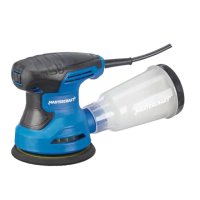headline bars
continuation tabs
notes
warnings
headline bars
continuation tabs
notes
warnings
headline bars
continuation tabs
notes
warnings
headline bars
continuation tabs
notes
warnings
headline bars
continuation tabs
notes
warnings
headline bars
continuation tabs
notes
warnings
model no. 054-7296-6 | contact us 1-800-689-9928
12
OPERATING INSTRUCTIONS
SELECT THE CORRECT SANDING PAPER GRADE
Available grades are: coarse, medium and fine. Use a coarse grit to sand rough finishes, medium grit to
smooth the work and fine grit to finish off.
It is best to make a trial run on a scrap piece of material to determine the optimum grades of sanding
paper for a particular job.
TURN THE SANDER ON AND OFF (
fig 5
)
1. Connect the plug on the sander’s power cord to a
standard household outlet.
2. Start the sander by pushing the “on/off” switch
to the “I” position.
3. Turn the sander off by pushing the “on/off”
switch to the “O” position.
SANDING
This sander can be used for most sanding operations on materials such as wood, plastic, metal and
painted surfaces. Do not use the sander for wet sanding.
1. Plug the sander to the power source.
2. Place the sander on the workpiece so that the sanding paper is flat and fully in contact with the
workpiece.
3. Start the sander.
4. For best sanding results, apply light pressure on the sander, but do not force the tool.
5. Move the sander slowly over the workpiece, making successive passes in parallel lines, circles, or
crosswise movements. The removal rate and the sanding pattern are determined by the choice of
sanding paper and the work surface.
6. Do not allow sanding on one spot too long, as the sander’s rapid action may remove too much
material and make the surface uneven.
7. Upon completion of the sanding operation, remove the sander from the workpiece, turn the sander
off and wait until it comes to a complete stop before putting it down.
fig 5
WARNING!
• Before connecting the sander to a power source, always check to be sure that the switch is in the off
position. Failure to do so could result in accidental starting of the sander, causing possible serious injury.
NOTICE: Applying additional pressure only slows the motor, rapidly wears sanding paper, and greatly reduces sander speed.
Excessive pressure will overload the motor, possibly causing damage from motor overheating and can result in inferior work.
On/off switch

